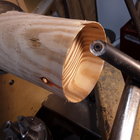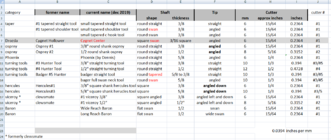@Mike Hunter - thanks for making your presence known, I did not know you hang out here.
After contemplating this discussion over the past few days, it finally dawned on me what the underlying problem is -
frame of reference.
I grew up learning and using the English system of measurement, as well as the English language. I was taught the metric system, some in jr hi, more in hi school, and more in college while acquiring an engineering degree. I spent ~20 years of my career working on a product type designed in metric units. Every time I had to convert the metric back to English units, because that is and will always be my frame of reference - feet, gallons, pounds, and not meters, liters, and grams. It doesn't matter that the base 10 decimal aspect of the metric system is easier (even the English gave up on the English system), my learned frame of reference is the English system, it is what I have a "feel" for.
I have many friends that are fluent in English as a 2nd language - all of them "think" in their native language, and "convert" to English.
HSS tools are the measurement & language system - the
frame of reference - for wood turning. There is a huge amount of info to build this frame of reference. Many people, and certainly the great turners we all admire, have created many charts, videos, articles, etc over many years to build this frame of reference.
The Hunter tools are an anomaly - they are distinctly different from HSS tools, and they are in a group of one. Having a unique product is wonderful, but......if that product is outside the frame of reference, the inability to relate the unique product to an existing frame of reference can be its downfall. What about the new(er) turner that hasn't developed the HSS tool frame of reference? Unfortunately 99% of the available info as well as fellow club members (the resources to help the poor noob) are all grounded in HSS tools.
That's the problem, so what's the solution? Well, my solution to the metric system is to have conversion charts, and of course, over time I memorized a lot of them, but I keep one on the wall in my shop. This does not discount the confusion with the Hunter tools themselves. Personally, I need a sortable speadsheet, downloadable from the website, that lists all the characteristics of the tools in a columnar format, so that I can sort by cutter size, shaft size, shaft shape, cutter set angle, etc. I can then sort through all that info, in many various ways, and start to build a
frame of reference for the tool offerings.
Then, I need a sortable chart that relates each tool to the approximate hss tool counterpart and the type of cut. This now starts to allow me to build a
conversion frame of reference. Highlighting the particular supposed advantages of the Hunter tools in particular situations would be next on my list (I always take claims with a grain of salt - I have to experience it or be able to directly relate to it to 100% believe it). It would be great if Mike Hunter could afford to get a bunch of demos and endorsements from popular turners, but that just drives up his operating costs.
Hunter tool question - the cutters have numbers relating to dia. The tools have names, and then numbers. Does the tool # always, no exception, relate to the cutter used? If not, do away with tool numbers and use something else, or use 2 digit #'s.


